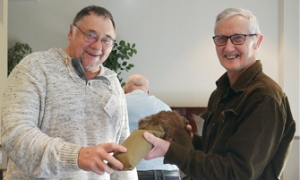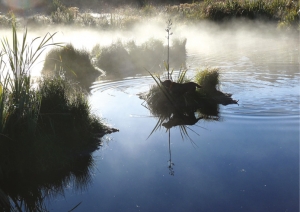Displaying items by tag: Shooting
Whistling as he works
The guest speaker at this year’s conference, Murray Stevenson, spoke about gun dogs and the importance of training them to suit the terrain. The three main groups of gun dogs – retrievers, spaniels and pointers/setters – all have very different temperaments and purposes.
He stressed the importance of letting puppies play and not putting too much pressure on them too early, saying to fully train a gun dog takes two years or more.
Experience has taught him that eight dogs equals eight times more work. It was important for owners of multiple dogs to give each dog one-on-one time and make sure none were left out.
He brought along some of his $3000 worth of dog training equipment with him and explained some basic techniques such as teaching pups to respond to a whistle rather than a human voice, and as a first step for them to learn “yes” and “no”.
Through a series of anecdotes, Murray described his experiences with different breeds. Labradors, he said, were easy to train as they were one-dimensional: they liked peanut butter sandwiches and retrieving ducks.
He said the two true bird dogs were the English pointer and English setter. Murray’s not-so-successful experience with owning an English setter taught him that they are good in long-range conditions but not suited to bush-covered, short-range conditions, and can be a challenge to train.
His advice for teaching a dog to run in a straight line is to train it along a fenceline, using incremental steps, so the dog can only deviate left or right, not both ways, making it easier to control.
He concluded by saying, “We hurry our training too much. Make sure your dog is 100 per cent right before you move on.”
Bring back lead shot
Call to bring back lead shot for duck shooting
The excitement of the shoot
Action at Ruffit Lodge east of Woodville
Something about opening day
Did You Know
Did You Know?
Good news for good shots
From a recent Council of Licensed Firearm Owners (COLFO) newsletter.
Please circulate and if you are not a member of COLFO and Sporting Shooters Association of New Zealand please consider joining. The bar stewards are not going to give up trying to take our hobby, sport and interests away from us:
A Win for Auckland Shooting Club and all NZ Shooting Ranges with financial assistance from Pistol New Zealand and COLFO, we are pleased to report that the Auckland Shooting Club has won its legal Battle with Auckland City Council to have its certificate of Compliance reinstated.
Auckland Council had revoked the certificate on the grounds of perceived lead contamination discharges to land and water.
If the Council stance had been upheld it could have heralded the end of shooting ranges in New Zealand.
This information has been provided by a DUNZ member.
The Anti-lead shot mythology
Way back in the 1950s research commenced to prove that wild waterfowl die from ingesting lead shot, but when this research failed to determine this hypothesis another pseudo research programme was created - one that saw huge numbers of captive waterfowl dosed with massive quantities of lead shot; this resulted in a number of birds dying! Hardly surprising as the amount of dosage was hundred times greater than any bird would intake in the wild.
Google – search for: Dosing ducks with lead shot.
In the late 1950s the United Nations latched on to the opportunity to establish a world-wide anti-lead programme, solely aimed at curtailing the growth of shooting sports and at the same time take firearms out of private hands!
In 2012 the UK’s high profile Countryside Alliance financed extensive research on lead in the environment; this determined that 30 commonly eaten foods all contained element of lead – none of which had come from lead shot!
Lead in the environment is a naturally occurring element and no-one appears to have died from eating any of the 30 foods listed in the CA research publication.
Australian scientist John Reid said this about ‘modern scientific research:
“There are issues concerning the way science and scientists are perceived by the public and by themselves. “Why is it assumed that science always gets it right, that only industry is capable of wrecking the environment? “
“There are issues about the way in which scientists continue to produce those environmental “threats” which have proven so useful in maintaining project funding.”
John Reid has also said:
“It works like this: activists, NZ - Forest & Bird, the Green Party, Dept of Conservation, etc., and overseas, the Wildfowl & Wetlands Trust, Royal Society for the Protection of Birds, US Fish & Game, etc use science to push for international action on a science-related issue in an area such as health or environment. Then, an international agreement is established, and the science on which it is has been based becomes institutionalised and funded by government. Time and again, when this happens, “the science” stops being science.
“This is because the scientists working on the relevant topic start being advocates and stop being researchers. After all, they are now being paid by the bureaucracy to support a particular doctrine, not to discover new stuff.”
http://blackjay.net/?p=237 (The Subversion of Science).
Recently – from the USA’s Hunt for Truth:
The crux of anti-hunting activists’ argument against traditional ammunition rests on the misplaced assertion that the use of lead ammunition for hunting leads to elevated lead exposure and poisoning in scavenging animals, such as the California condor, that allegedly ingest fragments of spent ammunition in gutpiles or carcasses left by hunters. The scientific studies relied on by the anti-lead proponents are in fact not scientifically sound.
The anti-lead ammunition proponents have employed psuedo science as a tool to support their distorted agenda. Indeed, the scientific studies used to impose lead ammunition bans are flawed. Researchers who have published these papers have used questionable sampling sizes and have ignored data believed to be contrary to their pre-conceived conclusions regarding lead ammunition. They have also routinely ignored evidence of alternative sources of lead in the environment as a potential cause of lead poisoning or mortality in wildlife. Key studies that profess to link lead ammunition to lead poisoning or mortality in wildlife have been criticised by scientists, and have even been embroiled in lawsuits for withholding original data that show results contrary to their published conclusions.
www.huntfortruth.org/myths/
In March 2015 I detailed the background to this anti-lead shot scenario pointing out that this has played the major role in the demise of the mallard – and possibly the demise of duck shooting in this country.
This was distributed widely – here and overseas – and here it has resulted in NZ Fish & Game admitting that there is a major problem with mallard numbers!
Neil Hayes
Blue Rock shoot at Martinborough
Game bird hunting season coming up
Better start getting ready
Top of the list should be the hunting licence, and probably the regulations booklet. Check out the Fish and Game website for the most up-to-date information. May 2 seems to be the opening day this year. Remember you must have your licence with you whenever and wherever you go hunting. Don’t try to use the licence from last year. They are not upgradable, exchangeable or refundable. If you lose your licence report it to Fish and Game and they will sort it out. F&G have an online licence system, or you can call their free phone licence number 0800 542 362, business hours only, $5 booking fee. Or you can visit any Fish and Game office or regional licence agent.
Hunting kit reminders:
- Game bird hunting licence, regulations booklet. Carry firearms licence at all times.
- Confirm access with landowners.
- Get permit to hunt on Fish & Game and DOC land.
- Fix the maimai: leaks, rotten boards seating etc.
- Clean decoys.
- Vaccinations and worming for the dog.
- Check regulations for the region you are hunting in.
- Hunt ethically and responsibly.
- Don’t drink and hunt. Alcohol impairs judgement.
- Be a tidy kiwi – take your rubbish when you leave.
Basic safety rules:
- Shotgun in tip-top condition. Check sighting.
- Treat every firearm as loaded.
- Store firearms and ammunition safely.
- Always point firearms in a safe direction.
- Load only when ready to fire.
- Always, always - identify your target.
- Check the firing zone.
Keep it happy hunting
With Duck Shooting seasons not far away it is well to remember about obligations of farm/land owners and of the recreational visitors on the property.
Owners do have obligations under Health and Safety legislation.
The first thing to take into account is that this is not a paperwork nightmare. There is not lengthy form-filling required nor a need to sign people on and off the farm. It is really a matter of thinking about where the hunters will go, identifying hazards and risks the hunters wouldn’t reasonably expect in those areas, and warning them about those risks and how to avoid them.
The recommendation is to have a conversation with the hunter or hunter in charge of the party to pass on that information. Make a note in your farm diary about what you told them. Most people usually ring up the night (or during the week) before to make sure it’s all ok, so that’s a good time to have the discussion.
Think about the sort of things to warn them about. Remember the things they wouldn’t reasonably expect (so if they are townies you might have to make allowance for that) in the areas they will be in. Some examples: Dangers from things like tree-felling, spraying or other work – if there is tree felling in another area, are the trucks using the same tracks? Areas of instability such as paddocks with unexpected tomos or subject to landslips. Aggressive stock that are near where they will be hunting. You might also let them know about communications (e.g. no cell coverage) so they can make alternate arrangements if they need to.
It’s also a good to get an idea of their timings, and tell them they should let you know if these change. You also need to make sure that all the people who are in the area (staff, contractors, other visitors / hunters) are aware of each other.
If a visitor trips over a tree-root or stone, a property owner or occupier is unlikely to be held responsible for the other person’s carelessness. In addition, if the property owner or occupier could not reasonably have been expected to know of a hazard, they cannot be held responsible for any harm that occurs to a customer or client.
Remember the General Rule - as the person in charge of the workplace you are legally required to point out specific hazards, which you know could harm the person and which the person wouldn’t normally expect to encounter.
Happy hunting season.


